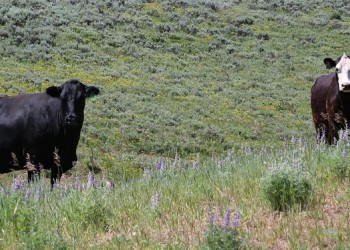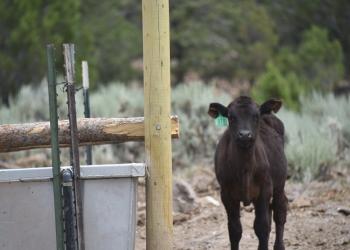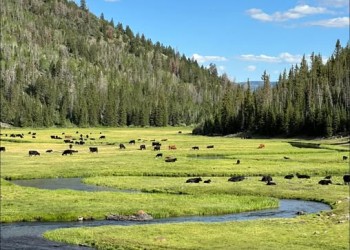Rangeland and Grazing
The Forest Service supports livestock grazing on National Forest System lands (National Forests and Grasslands). We believe that livestock grazing on these lands, if responsibly done, provides a valuable resource to the livestock owners as well as the American people.
The Fishlake National Forest has established maximum forage utilization standards. These standards are incorporated into each term grazing permit. Livestock, owned by local ranchers, utilize available forage on the forest. Local citizens in cooperation with the Forest Service have managed these grazing animals since the turn of the century. The permittees are responsible to maintain all structural improvements such as fences and water developments.
It is the Forest Service's goal to conserve the rich resources of the National Forests and Grasslands while supporting communities greatly dependent upon these very same resources. While grazing is an important use, we will continue to move forward with improving our management and preventing degradation of soil, water, and vegetation.
While the Forest Reserves were originally established to protect timberlands and watersheds, it was recognized early in the history of the Reserves (later National Forests) that grazing was a legitimate use. In 1897, the newly formed Forest Service was authorized by Congress to regulate grazing and permit it as long as it did not injure forest growth. The agency's controls (permits, herd size, allotments, season of use) were attempts to protect the resource and prevent the monopolization by large outfits (Rowley 1985).
The Forest Service has supported controlled livestock grazing since the very early days of the agency. The earliest version of published policy of the Forest Service (USDA Forest Service 1905), stated:
"The Forest Service will allow the use of the forage crop of the reserves as fully as the proper care and protection of the forests and the water supply permits. In new forest reserves where the livestock industry is of special importance, full grazing privileges will be given at first, and if reduction in number is afterwards found necessary, stockmen will be given ample opportunity to adjust their business to the new conditions. Every effort will be made to assist the stock owners to a satisfactory distribution of stock on the range in order to secure greater harmony among citizens, to reduce the waste of forage by tramping in unnecessary movement of stock, and to obtain a more permanent, judicious, and profitable use of the range. The leading objects of the grazing regulations are:
- The protection and conservative use of all forest reserve land adapted for grazing.
- The best permanent good of the live-stock industry through proper care and improvement of the grazing lands.
- The protection of the settler and home builder against unfair competition in the use of the range."
By the 1936 edition of the policies, it was recognized that the "cattle and sheep which are grazed in the national forests bear an important relation to the supply of beef and mutton in this country and represent an important industry and basis for established homes and every effort will be made by forest officers to promote the fullest possible use of grazing resources." (USDA Forest Service 1936)
While the relationship between the National Forests and the country's beef and mutton, and more recently lamb, supply declined in the 2nd half of the 20th century, livestock grazing remains an important and valid use of our national forests. According to the Multiple Use Sustained-Yield Act of 1960, "It is the policy of the Congress that the National Forests are established and shall be administered for outdoor recreation, range, timber, watershed, and wildlife and fish purposes." Current Forest Service objectives for the range management program are:
- To manage range vegetation to protect basic soil and water resources, provide for ecological diversity, improve or maintain environmental quality, and meet public needs for interrelated resource uses.
- To integrate management of range vegetation with other resource programs to achieve multiple use objectives contained in Forest land and resource management plans.
- To provide for livestock forage, wildlife food and habitat, outdoor recreation, and other resource values dependent on range vegetation.
- To contribute to the economic and social wellbeing of people by providing opportunities for economic diversity and by promoting stability for communities that depends on range resources for their livelihood.
- To provide expertise on range ecology, botany, and management of grazing animals.
It was never the intent of the Congress that all uses would occur on all areas. Individual forests determine what uses are feasible and appropriate for different areas through the development and revision of the Land and Resource Management Plans. Once a determination has been made that grazing is feasible and appropriate for an area, grazing is planned and managed taking into consideration all the other uses of the area.
The modern history of the west is very closely tied to livestock grazing. During the 1800's large ranching operations were established using the free forage available on unmanaged and unclaimed public domain lands. While the dominance of these cattle and sheep "empires" declined after restrictions on grazing began to occur in the early part of the 20th century, much of the custom and culture of the rural west is still very closely tied to ranching. Many rural communities continue to be dependent upon ranching for their economic livelihood and most of these ranches rely on federal land grazing, either on BLM managed lands or on National Forests, for at least a portion of the grazing.
It is the Forest Service's goal to conserve the rich resources of the National Forests and Grasslands while supporting communities greatly dependent upon these very same resources. While grazing is an important use, we will continue to move forward with improving our management and preventing degradation of soil, water, and vegetation.
References
Rowley, William D. 1985. U.S. Forest Service Grazing and Rangelands A History. Texas A&M University Press, College Station. 270 pp.
USDA Forest Service. 1905. The Use of the National Forest Reserves. Department of Agriculture, Washington DC. 80 pp.
USDA Forest Service. 1936. The Use Book - Grazing Section. Department of Agriculture, Washington DC. 113 pp.
Viewing and Downloading Annual Operating Instructions (AOIs)
After clicking on the district links below, please use the following instructions to view and download AOIs:
- Select an AOI to view document. After opening, select the "Download" button to save document to your selected location.
- Navigate to other districts or years by using the AOI > 2023 > District links at the top of the page.
- Documents are in Adobe PDF format and require free Adobe Acrobat Reader software to view. Download Adobe Acrobat Reader.
The Beaver District is divided into nine allotments. Each allotment has been divided into several pastures. Long-term allotment management plans, coupled with annual operating plans ensure livestock use is appropriately assigned to each pasture to provide protection to all associated resources.
For more information on district grazing practices, contact the Beaver Ranger District (435) 438-2436
2025 Annual Operating Instructions - Coming Soon
The Fillmore Ranger District is divided into 18 allotments. Each allotment, in turn, has been divided into several pastures. After annual planning, livestock use is assigned to each pasture to provide protection to all associated resources.
For more information on district grazing practices, contact the Fillmore Ranger District (435) 743-5721
2025 Annual Operating Instructions
The Fremont River Ranger District is divided into 13 allotments. Each allotment, in turn, has been divided into several pastures. After annual planning, livestock use is assigned to each pasture to provide protection to all associated resources.
For more information on district grazing practices, contact the Fremont River Ranger District (435) 836-2800
2025 Annual Operating Instructions
The Richfield Ranger District is divided into 25 major allotments. Each allotment has been divided into several pastures. Long term allotment management plans, coupled with annual operating plans ensure livestock use in appropriately assigned to each pasture in order to provide protection to all associated resources.
For more information on district grazing practices, contact the Richfield Ranger District (435) 896-9233
2025 Annual Operating Instructions
Allotment Management Plans

Range Management Studies






